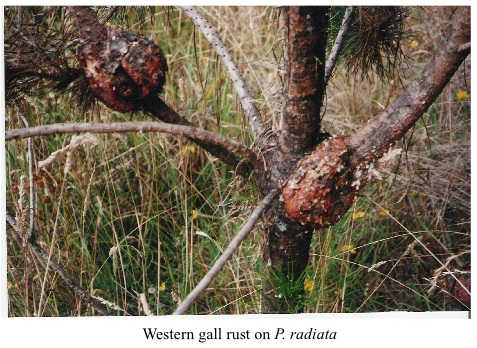PESTS AND DISEASES OF FORESTRY IN NEW ZEALAND
The potential distribution of western gall rust in New Zealand
Scion is the leading provider of forest-related knowledge in New Zealand
Formerly known as the Forest Research Institute, Scion has been a leader in research relating to forest health for over 50 years. The Rotorua-based Crown Research Institute continues to provide science that will protect all forests from damage caused by insect pests, pathogens and weeds. The information presented below arises from these research activities.
From Forest Health News 152, June 2005.
Western gall rust (Endocronartium harknessii syn. Peridermium harknessii) causes a serious disease on two- and three-needle hard pines, including Pinus radiata, in North America. Unlike most other rust diseases, western gall rust does not require an alternate host to complete its lifecycle; therefore, if it arrived in New Zealand, it would be able to spread directly from pine to pine.
 The potential risk that western gall rust poses to New Zealand has been recognised for at least 40 years but the pathogen has not arrived here.
The potential risk that western gall rust poses to New Zealand has been recognised for at least 40 years but the pathogen has not arrived here.
It has always been assumed that New Zealand would be climatically suitable for western gall rust because its geographic range extends from Mexico to the Yukon and from the Pacific to the Atlantic coasts of North America, and because P. radiata in California can be extensively damaged by the pathogen. This assumption has never been rigorously tested. As part of the FRST programme, a climate-modelling project for this pathogen has been undertaken in collaboration with scientists Det Vogler and Brian Geils of the USDA Forest Service. Dr Geils has undertaken a similar project with the white pine blister rust pathogen, Cronartium ribicola, to model the potential distribution of the pathogen in Mexico.
The epidemiology of western gall rust in North America has been extensively studied and we understand the conditions necessary for sporulation, how far the spores can be dispersed, and what affects spore survival. The infection process and host plant susceptibility are also well understood.
In this project, we are attempting to combine the published epidemiological data with the fine-scale geographic distribution and climatic data that are becoming available to provide a robust model of the potential distribution of western gall rust in New Zealand if the fungus were to become established here. The results of this research will increase our understanding of the potential of rust disease establishment in New Zealand.
Tod Ramsfield and Darren Kriticos (Ensis)
This information is intended for general interest only. It is not intended to be a substitute for specific specialist advice on any matter and should not be relied on for that purpose. Scion will not be liable for any direct, indirect, incidental, special, consequential or exemplary damages, loss of profits, or any other intangible losses that result from using the information provided on this site.
(Scion is the trading name of the New Zealand Forest Research Institute Limited.)

 Farm Forestry New Zealand
Farm Forestry New Zealand

